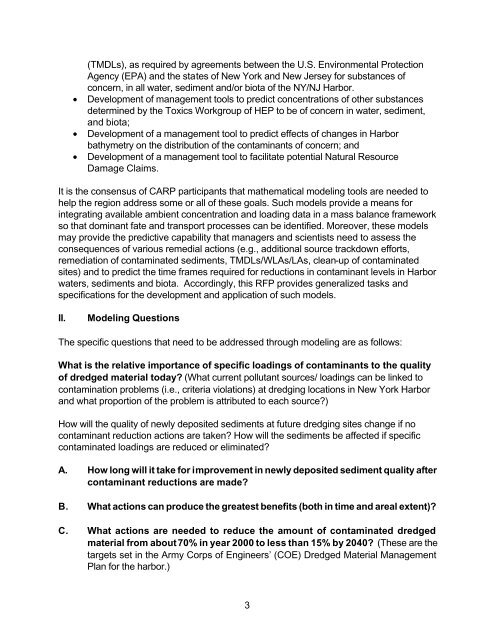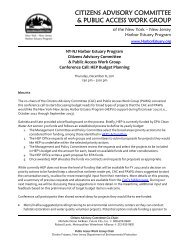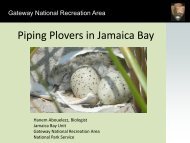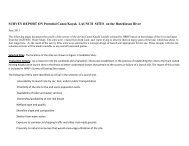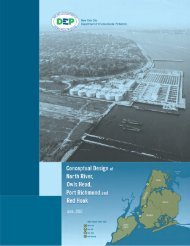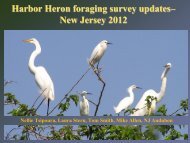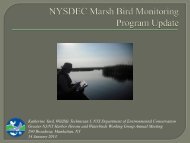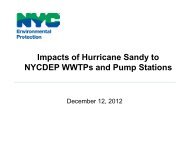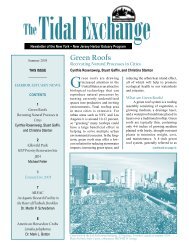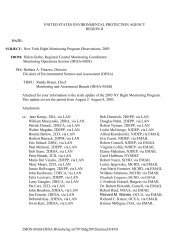A Model for the Evaluation and Management of Contaminants of ...
A Model for the Evaluation and Management of Contaminants of ...
A Model for the Evaluation and Management of Contaminants of ...
Create successful ePaper yourself
Turn your PDF publications into a flip-book with our unique Google optimized e-Paper software.
(TMDLs), as required by agreements between <strong>the</strong> U.S. Environmental Protection<br />
Agency (EPA) <strong>and</strong> <strong>the</strong> states <strong>of</strong> New York <strong>and</strong> New Jersey <strong>for</strong> substances <strong>of</strong><br />
concern, in all water, sediment <strong>and</strong>/or biota <strong>of</strong> <strong>the</strong> NY/NJ Harbor.<br />
• Development <strong>of</strong> management tools to predict concentrations <strong>of</strong> o<strong>the</strong>r substances<br />
determined by <strong>the</strong> Toxics Workgroup <strong>of</strong> HEP to be <strong>of</strong> concern in water, sediment,<br />
<strong>and</strong> biota;<br />
• Development <strong>of</strong> a management tool to predict effects <strong>of</strong> changes in Harbor<br />
bathymetry on <strong>the</strong> distribution <strong>of</strong> <strong>the</strong> contaminants <strong>of</strong> concern; <strong>and</strong><br />
• Development <strong>of</strong> a management tool to facilitate potential Natural Resource<br />
Damage Claims.<br />
It is <strong>the</strong> consensus <strong>of</strong> CARP participants that ma<strong>the</strong>matical modeling tools are needed to<br />
help <strong>the</strong> region address some or all <strong>of</strong> <strong>the</strong>se goals. Such models provide a means <strong>for</strong><br />
integrating available ambient concentration <strong>and</strong> loading data in a mass balance framework<br />
so that dominant fate <strong>and</strong> transport processes can be identified. Moreover, <strong>the</strong>se models<br />
may provide <strong>the</strong> predictive capability that managers <strong>and</strong> scientists need to assess <strong>the</strong><br />
consequences <strong>of</strong> various remedial actions (e.g., additional source trackdown ef<strong>for</strong>ts,<br />
remediation <strong>of</strong> contaminated sediments, TMDLs/WLAs/LAs, clean-up <strong>of</strong> contaminated<br />
sites) <strong>and</strong> to predict <strong>the</strong> time frames required <strong>for</strong> reductions in contaminant levels in Harbor<br />
waters, sediments <strong>and</strong> biota. Accordingly, this RFP provides generalized tasks <strong>and</strong><br />
specifications <strong>for</strong> <strong>the</strong> development <strong>and</strong> application <strong>of</strong> such models.<br />
II.<br />
<strong>Model</strong>ing Questions<br />
The specific questions that need to be addressed through modeling are as follows:<br />
What is <strong>the</strong> relative importance <strong>of</strong> specific loadings <strong>of</strong> contaminants to <strong>the</strong> quality<br />
<strong>of</strong> dredged material today? (What current pollutant sources/ loadings can be linked to<br />
contamination problems (i.e., criteria violations) at dredging locations in New York Harbor<br />
<strong>and</strong> what proportion <strong>of</strong> <strong>the</strong> problem is attributed to each source?)<br />
How will <strong>the</strong> quality <strong>of</strong> newly deposited sediments at future dredging sites change if no<br />
contaminant reduction actions are taken? How will <strong>the</strong> sediments be affected if specific<br />
contaminated loadings are reduced or eliminated?<br />
A. How long will it take <strong>for</strong> improvement in newly deposited sediment quality after<br />
contaminant reductions are made?<br />
B. What actions can produce <strong>the</strong> greatest benefits (both in time <strong>and</strong> areal extent)?<br />
C. What actions are needed to reduce <strong>the</strong> amount <strong>of</strong> contaminated dredged<br />
material from about 70% in year 2000 to less than 15% by 2040? (These are <strong>the</strong><br />
targets set in <strong>the</strong> Army Corps <strong>of</strong> Engineers’ (COE) Dredged Material <strong>Management</strong><br />
Plan <strong>for</strong> <strong>the</strong> harbor.)<br />
3


